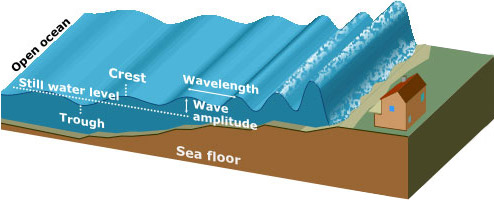Tsunami Characteristics
Tsunamis are characterized as shallow-water waves. Shallow-water waves are different from wind-generated waves, the waves many of us have observed at the beach. Wind-generated waves usually have period (time between two successional waves) of five to twenty seconds and a wavelength (distance between two successional waves) of about 300 to 600 ft. (100 to 200 meters). A tsunami can have a period in the range of ten minutes to two hours and a wavelength in excess of 300 miles (500 km).

It is because of their long wavelengths that tsunamis behave as shallow-water waves. A wave is characterized as a shallow-water wave when the ratio between the water depth and its wavelength gets very small. The speed of a shallow-water wave is equal to the square root of the product of the acceleration of gravity (32ft/sec/sec or 980cm/sec/sec) and the depth of the water. The rate at which a wave loses its energy is inversely related to its wavelength. Since a tsunami has a very large wavelength, it will lose little energy as it propagates. Hence in very deep water, a tsunami will travel at high speeds and travel great transoceanic distances with limited energy loss. For example, when the ocean is 20,000 ft. (6100 m) deep, unnoticed tsunamis travel about 550 miles per hour (890 km/hr), the speed of a jet airplane. And they can move from one side of the Pacific Ocean to the other side in less than one day.
As a tsunami leaves the deep water of the open sea and propagates into the more shallow waters near the coast, it undergoes a transformation. Since the speed of the tsunami is related to the water depth, as the depth of the water decreases, the speed of the tsunami diminishes. The change of total energy of the tsunami remains constant. Therefore, the speed of the tsunami decreases as it enters shallower water, and the height of the wave grows. Because of this “shoaling” effect, a tsunami that was imperceptible in deep water may grow to be several feet or more in height.
When a tsunami finally reaches the shore, it may appear as a rapidly rising or falling tide, a series of breaking waves, or even a bore. Reefs, bays, entrances to rivers, undersea features and the slope of the beach all help to modify the tsunami as it approaches the shore. Tsunamis rarely become great, towering breaking waves. Sometimes the tsunami may break far offshore. Or it may form into a bore: a step-like wave with a steep breaking front. A bore can happen if the tsunami moves from deep water into a shallow bay or river. The water level on shore can rise many feet. In extreme cases, water level can rise to more than 50 ft. (15 m) for tsunamis of distant origin and over 100 ft. (30 m) for tsunamis generated near the earthquake’s epicenter. The first wave may not be the largest in the series of waves. One coastal area may see no damaging wave activity while in another area destructive waves can be large and violent. The flooding of an area can extend inland by 1000 ft. (305 m) or more, covering large expanses of land with water and debris. Flooding tsunami waves tend to carry loose objects and people out to sea when they retreat. Tsunamis may reach a maximum vertical height onshore above sea level, called a runup height, of 98 ft. (30 meters). A notable exception is the landslide-generated tsunami in Lituya Bay, Alaska in 1958, which produced a 1722 ft. wave (525 m).
